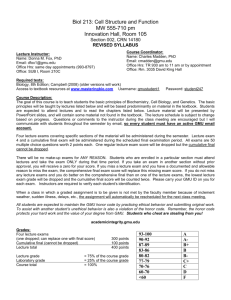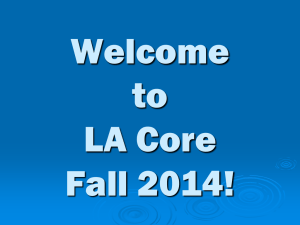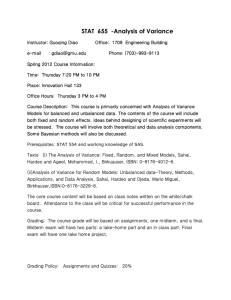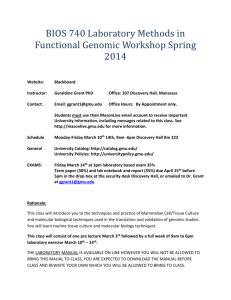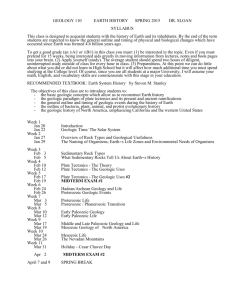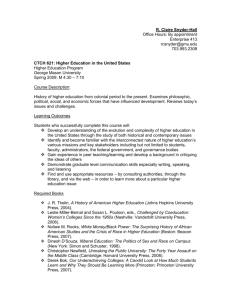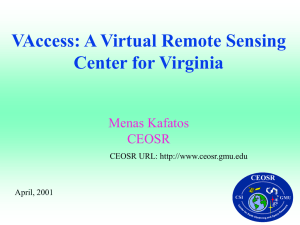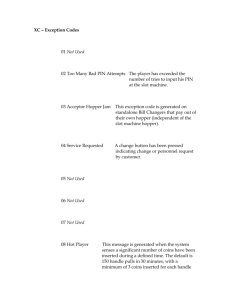See Syllabus
advertisement
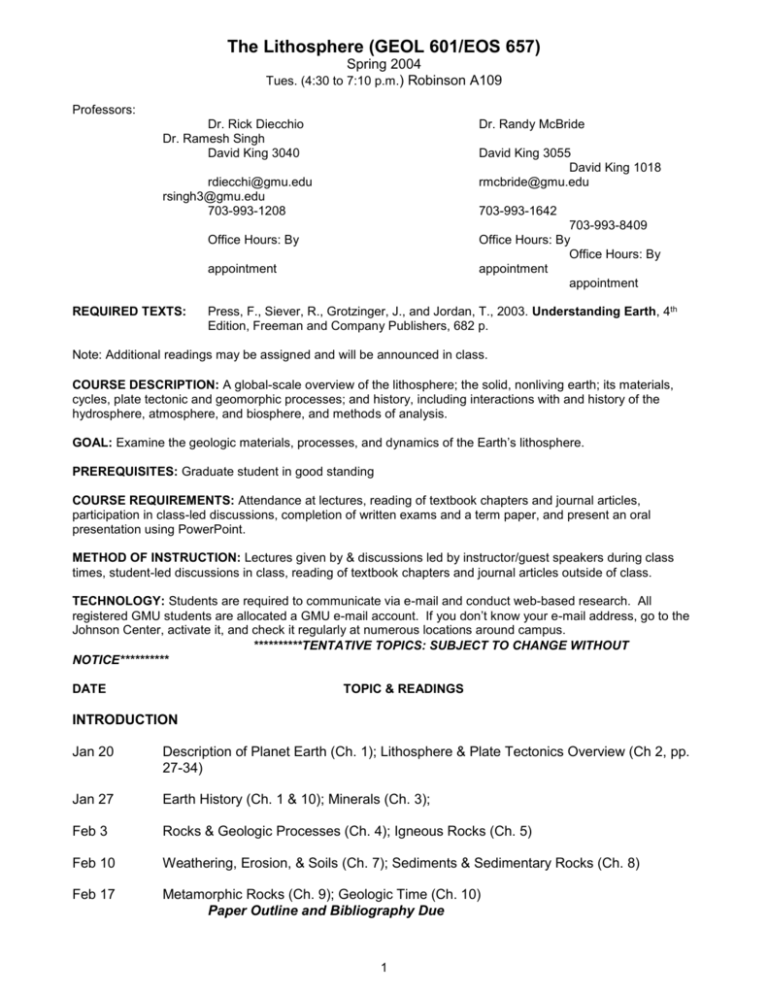
The Lithosphere (GEOL 601/EOS 657) Spring 2004 Tues. (4:30 to 7:10 p.m.) Robinson A109 Professors: Dr. Rick Diecchio Dr. Ramesh Singh David King 3040 Dr. Randy McBride David King 3055 David King 1018 rmcbride@gmu.edu rdiecchi@gmu.edu rsingh3@gmu.edu 703-993-1208 703-993-1642 703-993-8409 Office Hours: By Office Hours: By appointment appointment Office Hours: By appointment REQUIRED TEXTS: Press, F., Siever, R., Grotzinger, J., and Jordan, T., 2003. Understanding Earth, 4th Edition, Freeman and Company Publishers, 682 p. Note: Additional readings may be assigned and will be announced in class. COURSE DESCRIPTION: A global-scale overview of the lithosphere; the solid, nonliving earth; its materials, cycles, plate tectonic and geomorphic processes; and history, including interactions with and history of the hydrosphere, atmosphere, and biosphere, and methods of analysis. GOAL: Examine the geologic materials, processes, and dynamics of the Earth’s lithosphere. PREREQUISITES: Graduate student in good standing COURSE REQUIREMENTS: Attendance at lectures, reading of textbook chapters and journal articles, participation in class-led discussions, completion of written exams and a term paper, and present an oral presentation using PowerPoint. METHOD OF INSTRUCTION: Lectures given by & discussions led by instructor/guest speakers during class times, student-led discussions in class, reading of textbook chapters and journal articles outside of class. TECHNOLOGY: Students are required to communicate via e-mail and conduct web-based research. All registered GMU students are allocated a GMU e-mail account. If you don’t know your e-mail address, go to the Johnson Center, activate it, and check it regularly at numerous locations around campus. **********TENTATIVE TOPICS: SUBJECT TO CHANGE WITHOUT NOTICE********** DATE TOPIC & READINGS INTRODUCTION Jan 20 Description of Planet Earth (Ch. 1); Lithosphere & Plate Tectonics Overview (Ch 2, pp. 27-34) Jan 27 Earth History (Ch. 1 & 10); Minerals (Ch. 3); Feb 3 Rocks & Geologic Processes (Ch. 4); Igneous Rocks (Ch. 5) Feb 10 Weathering, Erosion, & Soils (Ch. 7); Sediments & Sedimentary Rocks (Ch. 8) Feb 17 Metamorphic Rocks (Ch. 9); Geologic Time (Ch. 10) Paper Outline and Bibliography Due 1 EARTH’S INTERIOR & ENDOGENIC PROCESSES Feb 24 Plate Tectonics (Ch. 2) Mar 2 Volcanism (Ch. 6); Earthquakes (Ch. 19) Hand Out Mid-Term Exam Spring Break Mar 7 Mar 16 Evolution of Continents (Ch. 20) Mid-Term Exam Due Mar 23 Exploring Earth’s Interior (Ch. 21) Mar 30 Basic Principles of Geophysical Methods, EXOGENIC PROCESSES Mass Wasting (Ch. 12) Apr 6 Fluvial Processes & Landforms (Ch. 14) Term Papers Due Apr 13 Glacial Processes & Landforms (Ch. 15) Apr 20 Aeolian Processes & Landforms (Ch. 16); Coastal Processes & Landforms (Ch. 17) Apr 27 Landscapes (Ch 18); Oral Presentations May 4 Final Exam Due GRADING: Graduates Midterm exam 20% Final Exam (comprehensive) Paper 30% 30% 1 to 2 Page Outline & Bibliography (4%) Final paper (26%) Oral Presentation Participation 15% 5% 100% Exams may cover lectures, text readings, assigned articles, slides, overheads, videos, and any handouts. Exams must be turned in as scheduled. Otherwise, any exam not turned in will be scored a “zero.” GRADE SCALE: A+ = 97 - 100% A = 93 - 96% A- = 90 - 92% B+ = 87 - 89% 2 B = 83 - 86% B- = 80 - 82% C = 70 - 79% F = 0 - 69% Adherence to The GMU Honor Code is expected of all students. PAPER TOPICS: 1. Carbon cycle: natural vs. anthropogenic effects 2. Remote sensing of Earth materials: capabilities and limitations 3. Remote sensing of Earth processes: capabilities and limitations a. Mass wasting b. Fluvial c. Glacial d. Aeolian e. Coastal 4. Cycling of crustal and mantle materials 5. Tectonic coastal classification: primary geomorphic features using remote sensing 6. Delineating physical impacts of earthquakes using remote sensing 7. Understanding endogenic processes using geophysical methods PAPER OUTLINE AND BIBLIOGRAPHY (1 or 2 pages) Submit a detailed outline of your paper in the correct format as described below including the following: official title, your name, affiliation, all primary headings, potential secondary headings, text bullets, primary figures (if possible), and bibliography. In other words, you should submit a complete skeleton of your paper (framework is there, only the sentences are needed). The bibliography must contain at least eight (8) bibliographic citations from the following specific sources: journal articles, books, book chapters, government documents, theses/dissertations, and published field guides. Information from the World Wide Web (see handout about “Using the Internet for Geology Term Papers”) and other sources (e.g., National Geographic) are acceptable but must be in addition to the eight citations mentioned above. Newspaper articles are unacceptable sources of information. PAPER FORMAT: The typed paper must be 14 to 18 pages in length (excluding title page, figures, tables, references, and appendices), double spaced, 1" margins on all four sides, sequential page numbers on every page, and 11 point font. Each figure and table should have a caption and reference citation, and be numbered sequentially. The paper should be presented as a scientific, technical paper with the following components as primary headings: Abstract Introduction and Objectives Geologic Setting Methods (if appropriate) Results Discussion Conclusions References 3 Appendices ORAL PRESENTATION A 20-minute synthesis of your term paper will be presented orally in class using PowerPoint. Your presentation should emphasize images of the Earth’s surface or interior. Burn your PowerPoint presentation to a CD and bring it to class. Further details about the talks will be handed out in class. 4

